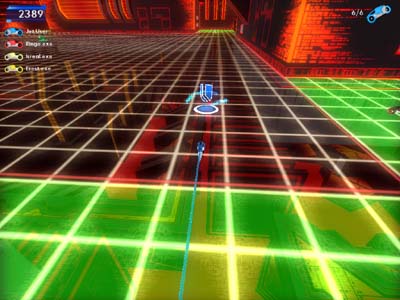Image Quality Analysis Fall 2003: A Glance Through the Looking Glass
by Derek Wilson on December 10, 2003 11:14 PM EST- Posted in
- GPUs
Color and Alpha
There is an incredible volume of technology that goes into producing a 3D scene in real-time. Due to the vast amount of information on this topic, we will only be covering the points necessary to help understand the visual differences we saw in the games that we tested. And what better place to start than one of the most basic aspects of any image: color.In a computer, the color of a pixel is determined by four values: red, green, blue, and alpha. Red, green, and blue are the primary colors of light and can be combined in different intensities to create millions of other colors. The alpha value is a specification of how opaque or translucent a color should be, which allows for some very complex layering effects and translucent objects that can't be achieved with color alone (this is called alpha blending).
 |
The translucent floor in this scene is a good
example of what alpha blending can do. (Click to enlarge.) |
Using a lot of alpha blending can bring just about any GPU to a crawl. In light of the limitations of human visual perception and the accuracy of color representation in a computer, very translucent objects can be discarded, since the alpha blending won't significantly change the color of the final result. It is common practice in the world of 3D graphics to put a threshold on how opaque something needs to be before it is considered for drawing at all. This really helps to speed up rendering, and (ideally) doesn't impact the experience of the game at all.










35 Comments
View All Comments
nourdmrolNMT1 - Thursday, December 11, 2003 - link
i hate flame wars but, blackshrike....there is hardly any difference between the images. and nvidia used to be way behind in that area. so they have caught up, and are actually in some instances doing more work to get the image to look a little different, or maybe they render everything that should be there, while ati doesnt (halo 2)
MIKE
Icewind - Thursday, December 11, 2003 - link
I have no idea what your bitching about Blackshrike, the UT2k3 pics look exactly the same to me.Perhaps you should go work for for AT and run benchmarks how you want them done instead of whining like a damn 5 year old..sheesh.
Shinei - Thursday, December 11, 2003 - link
Maybe I'm going blind at only 17, but I couldn't tell a difference between nVidia's and ATI's AF, and I even had a hard time seeing the effects of the AA. I agree with AT's conclusion, it's very hard to tell which one is better, and it's especially hard to tell the difference when you're in the middle of a firefight; yes, it's nice to have 16xAF and 6xAA, but is it NECESSARY if it looks pretty at 3 frames per second? I'm thinking "No"; performance > quality, that's why quality is called a LUXURY and not a requirement.Now I imagine that since I didn't hop up and down and screech "omg nvidia is cheeting ATI owns nvidia" like a howler monkey on LSD, I'll be called an nVidia fanboy and/or told that A) I'm blind, B) my monitor sucks, C) I'm color blind, and D) my head is up my biased ass. Did I meet all the basic insults from ATI fanboys, or are there some creative souls out there who can top that comprehensive list? ;)
nastyemu25 - Thursday, December 11, 2003 - link
cheer up emo kidBlackShrike - Thursday, December 11, 2003 - link
For my first line I forget to say blurry textures on the nvidia card. Sry, I was frustrated at the article.BlackShrike - Thursday, December 11, 2003 - link
Argh, this article concluded suddenly and without concluding anything. Not to mention, I saw definite blurry textures in UT 2003, and TRAOD. Not to mention the use of D3D AF Tester seemed to imply a major problem with one or the other hardware but they didn't use it at different levels of AF. I mean I only use 4-8 AF, I'd like to see the difference.AND ANOTHER THING. OKAY THE TWO ARE ABOUT THE SAME IN AF BUT IN AA ATI USUALLY WINS. SO, IF YOU CAN'T CONCLUDE ANYTHING, GIVE US A PERFORMACE CONCLUSION, like which runs better with AA or AF? Which creates the best with both settings enabled?
Oh and AT. Remember back to the very first ATI 9700 Pro, you did tests with 6x AA and 16 AF. DO IT AGAIN. I want to see which is faster and better quality when their settings are absoulutely maxed out. Because I prefer playing 1024*768 at 6x AA and 16 AF then 1600*1200 at 4x AA 8x AF because I have a small moniter.
I am VERY disappointed in this article. You say Nvidia has cleaned up their act, but you don't prove anything conclusive as to why. You say they are similar but don't say why. The D3D AF Tester was totally different for the different levels. WHAT DOES THIS MEAN? Come on Anand clean up this article, it's very poorly designed and concluded and is not at all like your other GPU articles.
retrospooty - Thursday, December 11, 2003 - link
Well a Sony G500 is pretty good in my book =)Hanners - Thursday, December 11, 2003 - link
Not a bad article per se - Shame about the mistakes in the filtering section and the massive jumping to conclusions regarding Halo.gordon151 - Thursday, December 11, 2003 - link
I'm with #6 and the sucky monitor theory :P.Icewind - Thursday, December 11, 2003 - link
Or your monitor sucks #5ATI wins either way